#irishsailing – Ireland is having a busy sailing season through 2014, but there is concern about the decline in turnouts in some major events. W M Nixon suggests that, during the years we've been pre-occupied with weathering the economic storm, we may have missed the fact that the basic structure of sailing is changing.
We've lived through interesting times, these past few years. And with Ireland's particular woes during the global financial crisis, the general lack of money and resources, coupled with the decline in simple enthusiasm for living energetically and enjoying participant sport, has obscured the fact that sailing – like most sports – has been changing, with an increasing emphasis on focussing attention on a few big professional events, rather than celebrating the small and the local.
A clear case in point was the visit of the Clipper Race to Derry/Londonderry, which coincided precisely with the weekend at the end of June when the biennial Round Ireland Race was staged from Wicklow. Although there were many entries racing round Ireland which had varying levels of what we might call soft sponsorship, essentially it was an unsponsored race for amateurs run by amateurs, something to which the mass media will give little if any attention.
But the Clipper Race by contrast is now a firmly established commercial venture based on a sound business model. Robin Knox-Johnston has certainly earned the event's success with his dedicated promotion of the ideal over the years, and the main sponsors – whether they be major brands, cities, regions or even countries - feel very comfortable with it. This is a corporate affair where all the big decision makers can be confident that there'll be a highly professional output of good human interest news stories. And if a television company sends down a film crew with a reporter to cover the stopover, the Clipper Race's own people will know exactly what they need, and thereby maximise their expensive time to produce newsworthy results.
As for the non-professional paying crews taking part, they're fully aware that they've divvied up the kind of money which would buy them their own very useful little boat if they so wished, and have a bit of money left over to run it too. But they much prefer to pay up front for what they know will be the sailing experience of a lifetime, all neatly packaged and ready to go, and everything done and dusted at the and of it.

Derry/Londonderry/Doire arrives at the entrance to Lough Foyle to win the Clipper Race's Transatlantic leg.
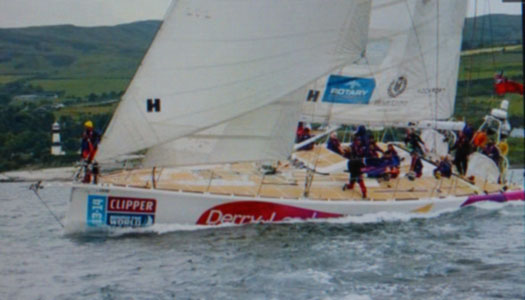
Home to victory – DLD making knots up Lough Foyle past the coast of Donegal
When the various pay-up-front round the world races were establishing themselves several decades ago, one noted newspaper sports editor famously agreed that they were the sporting equivalent of a fleet of tour buses full of paying passengers racing down the road from Dublin to Killarney. My own feeling was that a tour bus race would actually be great fun, but I could see the point that it was remote indeed from the purest concepts of sport.
Nevertheless the round the world operators have been whittled down over the years until the Clipper Race not only survives but actually thrives mightily, and has an image to die for. Far from being a specialised oddity, it is becoming mainstream. In Australia, the annual Sydney-Hobart Race struggles each year to get its entries above the hundred mark, so when the Clipper organisers suggested they might make Sydney-Hobart 2013 a leg of their course, the organisers – the prestigious Cruising Yacht Club of Australia – leapt at the chance. And as far as we're concerned in Ireland, it was a great success, as the Irish boat Legenderry, skippered by Sean McCarter of Donegal, was the winner of the Clipper division, while it was noted with added satisfaction that his hefty big "tour bus" had by no means been beaten by all the fancy out-and-out racing machines sailed by Hobart race veterans.

Sean McCarter aboard DLD – his class victory in the Sydney-Hobart Race made him the Afloat.ie "Sailor of the Month" for January.
But even in the best of all possible worlds, there is only so much in the way of resources for such events, and public attention is very limited and fickle. Yet in the end, public attention is what motivates sponsorship. For sure, in a small, specialised and intensely personal sport like sailing, there will always be a willingness by some company bosses to give a bit of help to a friend organising a sailing event. But at the very least it has to be something which can in some way be justified on the balance sheet, and with the increasing dominance of the ubiquitous accountant, and his or her need in turn to justify aspects of the company's behaviour to the tax inspectors, the old "helping out a mate" approach to sailing sponsorship becomes increasingly difficult to justify.
Yet although almost all sailing enthusiasts will give a bit of their attention to events like the Clipper Race and the Sailing Olympics, while even the most hidebound traditionalist will occasionally take a furtive note of what's going on in the snakepit of the America's Cup, the fact is that for most of us, sailing is still primarily a matter of sailing our own boat, or crewing with old shipmates on someone else's craft, and taking part in club racing and local regattas which to us are the essence of the sport.
But in terms of outside attention, even in the town or village attached to our own home ports such beloved sporting activity scarcely registers at all in a world in which round-the-clock sporting highlights are available on the media or in a nearby stadium virtually all the time.
Most of Irish sailing is all about what Edmund Burke called "the little platoons". While Burke recognised the inevitable and growing power of the big battalions, he promoted the ideal of the vital function of the little platoons – basically the family unit, the extended family, and their circle of friends – in holding society together and preserving civilised life.
So instead of mindlessly banging the drum about Ireland being a great place to sail, and endlessly repeating the mantra about the Royal Cork being the world's first proper yacht club – true and all as both may be – perhaps it's time to be realistic about our sailing situation, cherish what we have, and thereby build it to a healthy state.
Admittedly if you go overboard on being realistic, you can quickly become pessimistic and reduce all home sailing activity in recognition of the fact that many people's sailing ideal is a warm and sunny fortnight in Croatia or the Greek Islands, sailing boats whose care and maintenance is someone else's responsibility, and sailing moreover on waters which won't give you hypothermia after an hour's immersion.

The legendary American offshore racer Carina rounding the Fastnet Rock in the race of 2011. Carina will be one of many contenders in the Fastnet Race of 2015, but like most of the large fleet, it's unlikely she'll enter any Irish port.
But the perception elsewhere is that Ireland is quite a rugged place to sail. In fact, for many who briefly sail in our waters every other year, the ruggedness of our waters is the USP of the Fastnet Race. The biennial Grand National of offshore racing is now the epitome of a "big battalions" event. With the added kudos of the 1979 disaster in its history, having a Fastnet Race in your sailing CV is a globally-recognised distinction. Thus we can be quite sure that next year's race will see the enormous but limited entry list filled almost instantly, and equally we can be sure that the Irish economy will scarcely benefit at all from a huge event which uses our most iconic rock as the main mark of the course, the very symbol of an entire vast international event, yet the race starts and finishes in the south of England.
As to the perception of Ireland's weather and our sailing conditions, ten days ago I was up at Ballyholme Bay on Belfast Lough for the annual F18 World Championship. The F18 is a hugely popular catamaran which thrives as a class where sailing waters are in easy reach of large populations. Thus its biggest fleets are along the north and northwest coasts of France, but it's big in Holland and Germany too, and in the south of France and Italy it prospers mightily.

Belfast Lough produced some fine Irish summer sailing weather for the F18 Worlds, and at the same time the F17 Worlds in the south of France were being disrupted by severe gales. Photo: W M Nixon
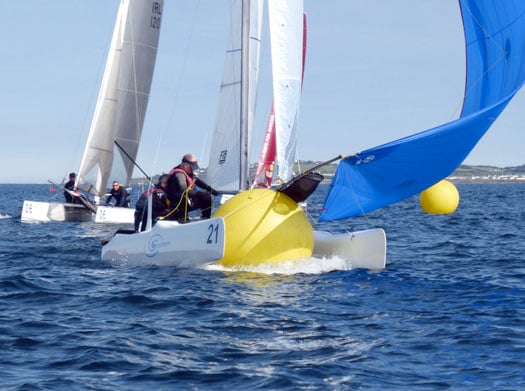
Whoops....it may have been a World Championship, yet there were some very human errors. But then, anyone accustomed to sailing a monohull could very easily forget you've a second hull to lee. Photo: W M Nixon
The 2013 Worlds in Italy attracted a fleet of 170 boats with thousands attending the opening festival. Then, as the well-run class has a policy of rotating the Worlds around countries which have a significant presence of F18s, the fact that it's the biggest catamaran class in Ireland saw the 2014 Worlds allocated to Ballyholme, Northern Ireland's premier dinghy club and a stronghold of F18 racing.
They knew that it would be wildly optimistic to expect a fleet to match Italy's lineup of 170 in 2013. But a target of a hundred boats seemed reasonable. Yet in the end they got 56. They'd great racing – much better than their smaller sisters the F17s which were being blown out of the water at the same time at their Worlds in the south of France. And with Gunnar Larssen of the Netherlands winning the title at his 13th attempt, there was a popular winner for a keen class of very pleasant people who were interesting and fun to be around.
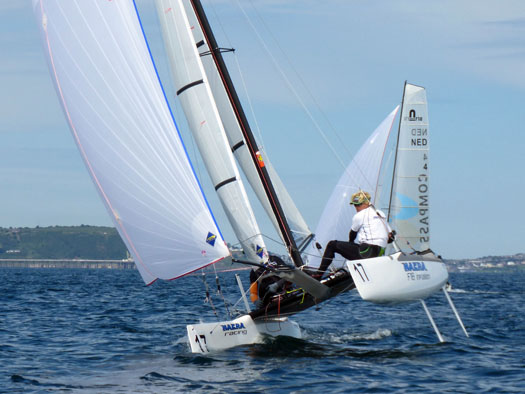
The F18s can be powered up in light breezes if you can get the weather hull clear.........Photo: W M Nixon

....and as the breeze builds, the hope is to have both crew on the wires......Photo: W M Nixon
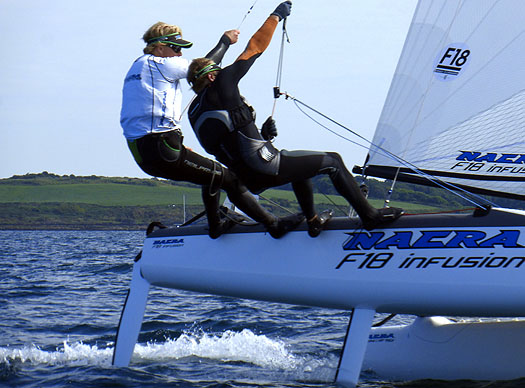
.....and then you're really cooking with gas. Photo: W M Nixon

It can be a knife edge. This may all look very relaxed, but it happened in jig time. Photo: W M Nixon
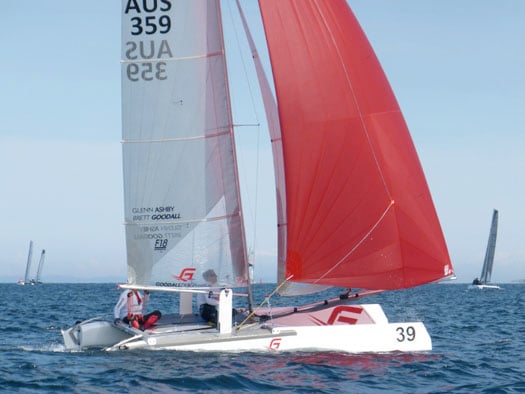
America's Cup rockstar Glenn Ashby of Australia was in the frame from time to time, but boat damage hindered his campaign. Photo: W M Nixon
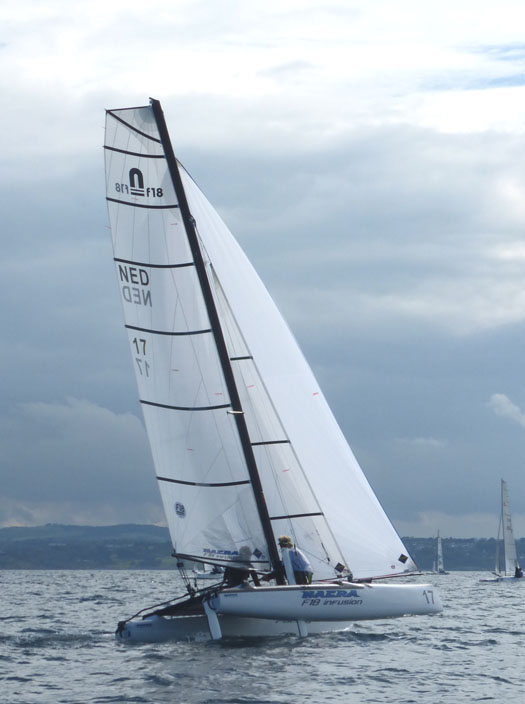
Despite his Viking name, new F18 World Champion Gunnar Larssen is Dutch. Here he gives a masterclass in winning out on a dead run (yes folks, this IS a dead run, but F18 style). Photo: W M Nixon

It was as the fleet came ashore that you realised the international nature of the entry. And the weather was Mediterranean, while in the Med itself, it was blowing a gale.....Photo: W M Nixon
As for a fleet of 56, it's more than enough to provide good sport, and they certainly had it. But it was a chilling – in every sense – reminder of the fact that, ever since Roman times, Ireland has been seen by the rest of Europe as Hibernia, the Land of Eternal Winter, and thus for the modern sailing world in general, we're seen as a small and distant island where only the most rugged would dream of going upon the sea.
Perhaps the turnout in any international event here could be directly calculated in relation to the distance of the venue from Mediterranean sailing conditions, qualified by the distance from Europe's main population centres. And lest anyone think that this compact turnout at Ballyholme was essentially to do with the special circumstances of Northern Ireland, at exactly the same time Cork Week saw numbers hovering around the hundred mark. And this in an event which fifteen years ago used to soar above five hundred.
It's a forceful reminded of how our sailing times are changing. If something is going to be very big in every way, then it can take up a lot of time and energy. But the old days of private owners divvying up resources and chivvying up crews in order to do a distant medium size regatta with all its logistical challenges seem to be a thing of the past, as the Scottish Series has also been finding out.
Yet if you visit every corner of Ireland, you'll be pleasantly surprised to find that on every coastline, any good anchorage is well filled with boats. After six years of economic stagnation, they may not be the newest boats around. But they're there in apparently greater numbers than ever, and they function happily in a strictly local environment.
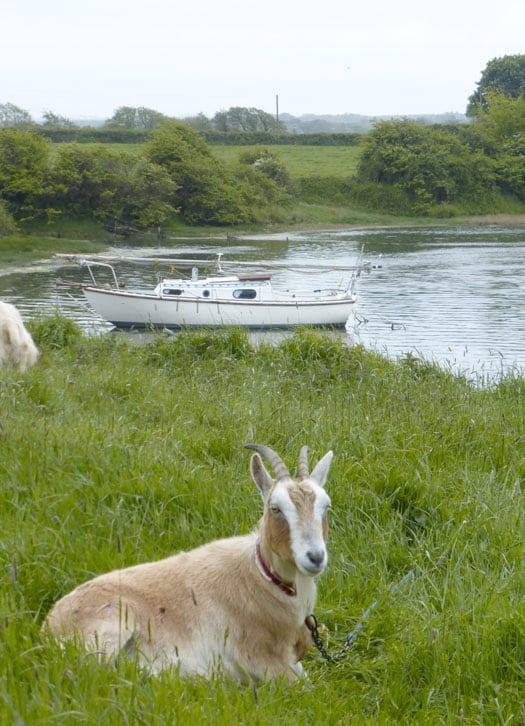
Ireland's hidden fleet (1). While getting a snap of this splendid goat at Ballylongford on the Shannon Estuary, we found our photo included a Macwester sloop, part of the growing local fleet in this remote inlet. Photo: W M Nixon
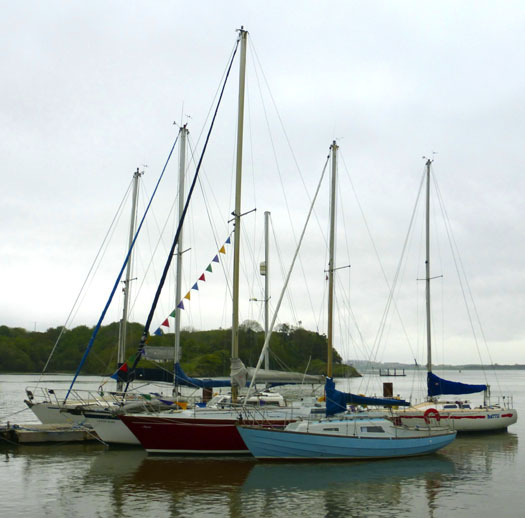
Ireland's hidden fleet (2). The cruiser-racers at Foynes YC have steadily increased in number for several years. This group includes two Irish-built boats on the right: an O'Brien Kennedy-designed Kerry, and a Ron Holland-designed Shamrock. Photo: W M Nixon
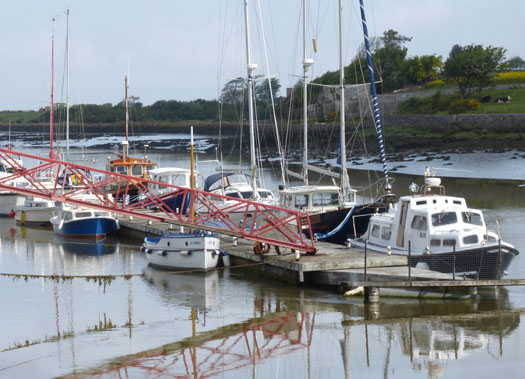
Ireland's hidden fleet (3). Up and down the Shannon, everyone will know of Askeaton in County Limerick, and Cyril Ryan's busy boatyard there. But who in the big outside world knows that this muddy creek is home to a fine fleet? Photo: W M Nixon
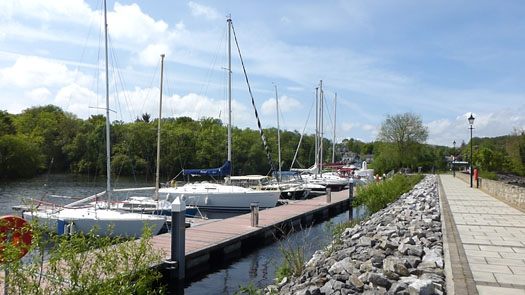
Ireland's hidden fleet (4). Talk of sailing on the Shannon lakes, and most folk will think of Lough Ree YC or Lough Derg YC, plus Iniscealtra SC at Mountshannon, and that's about it. But the extended harbour at Garrykennedy in Tipperary also has a fine fleet which wouldn't look out of place in a seaport. Photo: W M Nixon
It's something which will never be a headline-hitting sporting sensation, this quiet sailing enthusiasm of the little platoons. But it's there nevertheless, and as economic recovery picks up, who knows but we might be able to build it up into a slightly busier and better-supported sailing programme based on a realistic appreciation of the fact that while we may be a reasonably-sized island – the 30th largest in the world, to be precise – we're sparsely populated, we're relatively remote from the very big places, and we sail in a climate which can be rugged enough.
But as things get moving again, let's be realistic. There are grants available for clubs which wish to expand or develop their facilities. However, the message is: Don't simply think up some wizard scheme just to be able to avail of a grant. Instead, be realistic about what your really club and its membership really needs, and then -further down the line - see if it may be eligible for a grant. Such an approach will be to the benefit of everyone, and will help to build sailing's true image as a participant sport for all who are genuinely interested.
































































